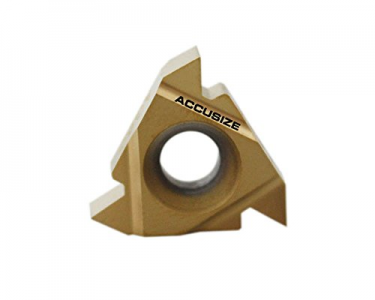- Joined
- Jan 3, 2015
- Messages
- 400
For the last couple of months, my main project around the shop has been moving threading onto a CNC Sherline lathe. Sort of by definition, anything that gets a small thread on it (say anything from 4-40 up to the biggest threads I've ever used) is going to be small enough for the Sherline's envelope. I have a Sherline long bed lathe that I bought back around '07 and converted to CNC. I threaded a couple of things back around 2008 or '09 but other than proving I could do it, I hardly ever touched that lathe.
This can be long a story and I don't know quite how long to make it. Not sure how much background is needed.
I'm running Mach3 and Windows 7 on the PC. Because I have three machines on the same PC and for the generally better performance you get this way, I'm running an Ethernet Smooth Stepper. Because the shop has moved around a bunch of times in the intervening 10 years, the lathe has been moved. The last time I tried to just move the axes on the lathe, it didn't respond at all and I had to resurrect all the hardware. When I went to hook up my home made optical sensor, it blew up. I had grabbed the wrong power pin.
I rebuilt it based on an optical interrupter (instead of reflective) from CNC4PC C3 card and made the hardware to mount it.
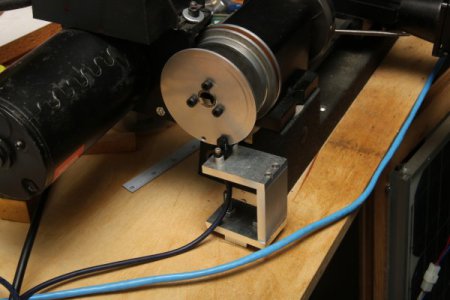
I have an oscilloscope and can watch the voltage pulses out of this. When I look at them, I see that the pulse is about 2-1/2 milliseconds long (2500 microseconds) but jitter about 200 microseconds. Call it +/- 100 usec. That's +/- 4%. Is that a problem? Don't know. Nothing to compare to.
I tried the scratch test and the first time it came out messy.
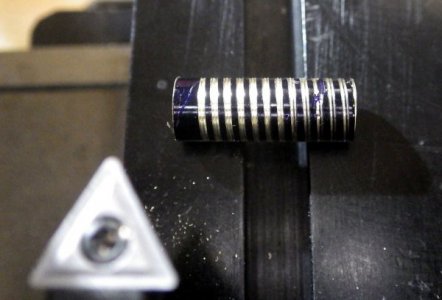
The threads look less like a"V" and more like a "W". Like it's missing the index or calculating something wrong. Plus the threads on the left look different. The peak of their W isn't as pronounced. I don't think it's a lighting trick or other photographic thing.
After Jim posted this update: https://www.hobby-machinist.com/threads/fanuc-ot-to-dc_cnc-conversion.66432/page-4#post-630786 One of the things it got me thinking of was just to run the motor faster. Plus I was suspicious the chuck might be loose.
Yesterday, I increased the motor speed from 200 to 300 and scratched a blank again. To be honest, I wasted a couple of days to get a successful scratch to this because I had Mach3 set in diameter mode and was entering the cutter positions in radius mode. Took me a while to realize the scratches weren't deep enough. Anyway, yesterday the overlapping 10 scratches looked like single scratch, so I decided to go for it and thread a test piece. 1/4-20.
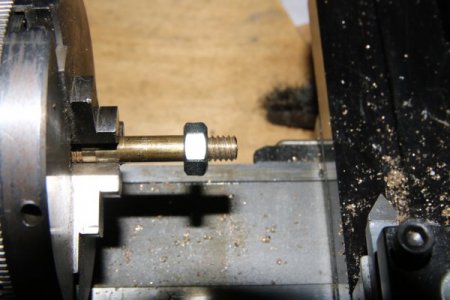
It was a little tight - I had to thread on that nut with a wrench, but it worked fine after that. This is a 1/2" long stretch of 1/4-20 threads.
Figuring that with CNC, if I can thread 1/4-20, I should be able to thread anything, I went for 10-32 in aluminum. Did the prep work on the manual lathe, and then set it up. First pass success. Again, I had to tighten the nut with a wrench, but aluminum would surely shear off if the threading was too far wrong.
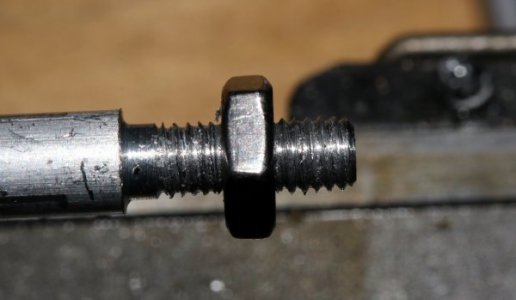
Although the nut screws on well, if you look closely at the left end of the thread, the shape isn't good. It looks like the cut varying from the right end to the left end is still there. It doesn't cut exactly the same path every time.
So I'm not quite done, but these threads are usable in a pinch. I want to make it better. My questions of the day are why the threads don't cut the same from end to end, and why do they seem to have more variation the farther into the cut I'm getting.
Can anyone tell me if the 4% variation in the pulse width/timing is normal? I see the RPM counter on the Mach3 Turn screen wobble around, too. Maybe from 295 to 302 when doing the 1/4-20 at 300 RPM and maybe a bit more variation when at 450 RPM for the 10-32. They don't seem to vary the full +/-4%, but maybe the display doesn't update quickly enough to see that. Could this variation all be from not using a tailstock? I didn't think so because I thought the right end would be worse.
This can be long a story and I don't know quite how long to make it. Not sure how much background is needed.
I'm running Mach3 and Windows 7 on the PC. Because I have three machines on the same PC and for the generally better performance you get this way, I'm running an Ethernet Smooth Stepper. Because the shop has moved around a bunch of times in the intervening 10 years, the lathe has been moved. The last time I tried to just move the axes on the lathe, it didn't respond at all and I had to resurrect all the hardware. When I went to hook up my home made optical sensor, it blew up. I had grabbed the wrong power pin.
I rebuilt it based on an optical interrupter (instead of reflective) from CNC4PC C3 card and made the hardware to mount it.

I have an oscilloscope and can watch the voltage pulses out of this. When I look at them, I see that the pulse is about 2-1/2 milliseconds long (2500 microseconds) but jitter about 200 microseconds. Call it +/- 100 usec. That's +/- 4%. Is that a problem? Don't know. Nothing to compare to.
I tried the scratch test and the first time it came out messy.

The threads look less like a"V" and more like a "W". Like it's missing the index or calculating something wrong. Plus the threads on the left look different. The peak of their W isn't as pronounced. I don't think it's a lighting trick or other photographic thing.
After Jim posted this update: https://www.hobby-machinist.com/threads/fanuc-ot-to-dc_cnc-conversion.66432/page-4#post-630786 One of the things it got me thinking of was just to run the motor faster. Plus I was suspicious the chuck might be loose.
Yesterday, I increased the motor speed from 200 to 300 and scratched a blank again. To be honest, I wasted a couple of days to get a successful scratch to this because I had Mach3 set in diameter mode and was entering the cutter positions in radius mode. Took me a while to realize the scratches weren't deep enough. Anyway, yesterday the overlapping 10 scratches looked like single scratch, so I decided to go for it and thread a test piece. 1/4-20.

It was a little tight - I had to thread on that nut with a wrench, but it worked fine after that. This is a 1/2" long stretch of 1/4-20 threads.
Figuring that with CNC, if I can thread 1/4-20, I should be able to thread anything, I went for 10-32 in aluminum. Did the prep work on the manual lathe, and then set it up. First pass success. Again, I had to tighten the nut with a wrench, but aluminum would surely shear off if the threading was too far wrong.

Although the nut screws on well, if you look closely at the left end of the thread, the shape isn't good. It looks like the cut varying from the right end to the left end is still there. It doesn't cut exactly the same path every time.
So I'm not quite done, but these threads are usable in a pinch. I want to make it better. My questions of the day are why the threads don't cut the same from end to end, and why do they seem to have more variation the farther into the cut I'm getting.
Can anyone tell me if the 4% variation in the pulse width/timing is normal? I see the RPM counter on the Mach3 Turn screen wobble around, too. Maybe from 295 to 302 when doing the 1/4-20 at 300 RPM and maybe a bit more variation when at 450 RPM for the 10-32. They don't seem to vary the full +/-4%, but maybe the display doesn't update quickly enough to see that. Could this variation all be from not using a tailstock? I didn't think so because I thought the right end would be worse.

